Herb Ryman’s work on EPCOT City for Walt Disney ended well before Walt Disney World’s debut in 1971. Ryman departed WED Enterprises that year, and set off on another round of world travels. He returned to the halls of Imagineering in 1976, though, in order to assist in the massive task of making EPCOT Center come to life.
Ryman’s paintings were an essential tool in selling the park’s concept to potential corporate sponsors, as well as in helping Walt Disney Productions figure out exactly what this unprecedented new project was going to be. He worked on ideas for EPCOT’s entrance, on the layout and atmosphere of World Showcase, and on individual pavilions for both Future World and World Showcase. His globetrotting experiences helped in this regard; his fascination with both Africa and the Orient led to his involvement with the China and Equatorial Africa pavilions.
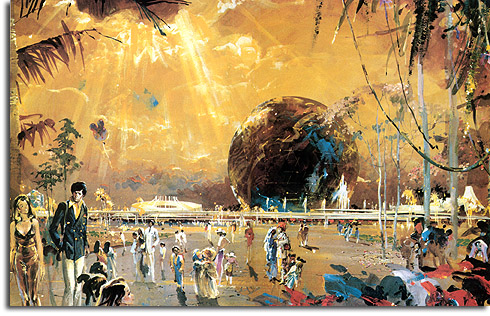 Ryman’s depiction of Spaceship Earth and EPCOT’s entrance plaza from 1978. Note the original, modern design for the American Adventure to the left.
Ryman’s depiction of Spaceship Earth and EPCOT’s entrance plaza from 1978. Note the original, modern design for the American Adventure to the left.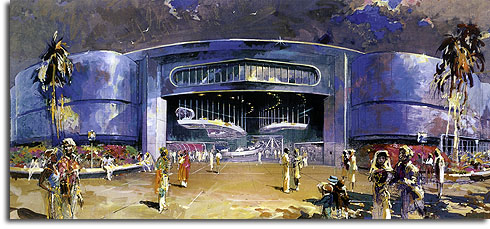 A rendering of EPCOT’s Transportation pavilion from 1979; before it became “World of Motion” the building had a more complicated design as shown here.
A rendering of EPCOT’s Transportation pavilion from 1979; before it became “World of Motion” the building had a more complicated design as shown here. An earlier rendering for a “Science & Invention” pavilion; this was a catch-all concept intended to snare corporate sponsors and some of its themes later emerged in Communicore and Horizons
An earlier rendering for a “Science & Invention” pavilion; this was a catch-all concept intended to snare corporate sponsors and some of its themes later emerged in Communicore and Horizons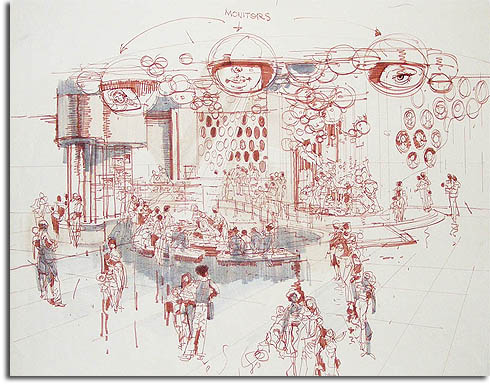 A Ryman sketch for an unknown EPCOT attraction; most likely this is an idea for an exhibit at Communicore
A Ryman sketch for an unknown EPCOT attraction; most likely this is an idea for an exhibit at Communicore Famous rendering of Spaceship Earth by Ryman; incidentally, this has served as my desktop background for many years
Famous rendering of Spaceship Earth by Ryman; incidentally, this has served as my desktop background for many years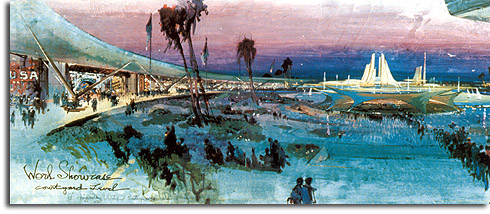 The same rendering from 1976 shows EPCOT in transition; World Showcase pavilions would be located in a semi-circular show building and would be the entrance to the park. The spires depicted were the visual “wienie” that beckoned guests into Future World.
The same rendering from 1976 shows EPCOT in transition; World Showcase pavilions would be located in a semi-circular show building and would be the entrance to the park. The spires depicted were the visual “wienie” that beckoned guests into Future World.This intriguing and rare sketch by Ryman, which I estimate to be from early 1977, shows a little-seen configuration for the park. World Showcase retains its original design concept that dated back to at least 1973 but which would be replaced some time in 1977 by a layout similar to the one we know today. Spaceship Earth has sprouted in Future World, replacing the spires. I’ve never seen any “official” Disney renderings featuring this particular configuration.
Other things of note include the WEDway train passing overhead – it was meant to encircle the lagoon. The “cruise ship” sketched on the lagoon resembles a similar craft that would appear in Harper Goff’s renderings of World Showcase a year later.
Ryman’s time spent in China and other Asian nations during the 1930s helped inspire his design work on the China pavilion. Herb would return to the Orient a few years after EPCOT’s debut; he made a special trip to see Tokyo Disneyland, for which he also did design work.
Ryman was also enthusiastic about the Equatorial Africa pavilion slated for inclusion in World Showcase. Asking to join Ken Anderson on the design team for the attraction, Ryman painted a number of inspirational paintings for the project. Along the way he befriended Roots author Alex Haley – a consultant on the pavilion. They would remain friends for the rest of Ryman’s life.
 The Waterhole – This piece depicts one of the two attractions intended for the Equatorial Africa pavilion, where guests would observe a jungle watering hole as night fell
The Waterhole – This piece depicts one of the two attractions intended for the Equatorial Africa pavilion, where guests would observe a jungle watering hole as night fellHerb’s work on the Equatorial Africa pavilion, much like his work on The Good Earth almost fifty years prior, inspired his desire to check out “the real thing” and so, in his early seventies, he set out on safari. This was an artistic safari, however, and Ryman would have a series of high adventures in Africa.
Ryman worked for several years on The American Adventure; various designers were asked to do treatments for different aspects of the attraction, and Herb was assigned the task of depicting “the multitudes”. So it was that many of his paintings showed the masses of people that have streamed into America over the years, and evoked the sense of “the melting pot.”
 Rendering of The American Adventure; not depicted is the American Gardens Theater, but there is a very nifty sailing ship from the 16th or 17th century
Rendering of The American Adventure; not depicted is the American Gardens Theater, but there is a very nifty sailing ship from the 16th or 17th century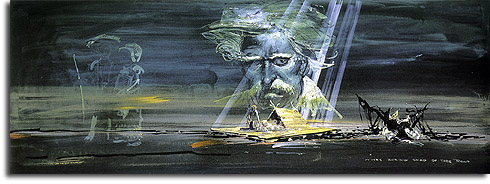 In this rendering of the “mighty Mississippi”, the floating raft isn’t occupied by Frederick Douglass, but rather Huckleberry Finn and Jim
In this rendering of the “mighty Mississippi”, the floating raft isn’t occupied by Frederick Douglass, but rather Huckleberry Finn and Jim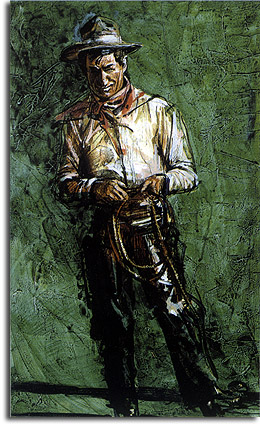 Humorist Will Rogers was originally intended as a third host of The American Adventure, as seen in this painting from 1976
Humorist Will Rogers was originally intended as a third host of The American Adventure, as seen in this painting from 1976Ryman seemed to be proud of his work on EPCOT; he speaks fondly of it in A Brush With Disney. But I found this quote fascinating and, looking at the park today, somewhat sad:
These pavilions are all confined as little pieces of pie along the lagoon. I think it’s very interesting to envision that we’ve got room for many other nations to squeeze in between these pieces of the pie. If the imagination is still working, there can be lots of nations along there.
If only, Herb… if only!
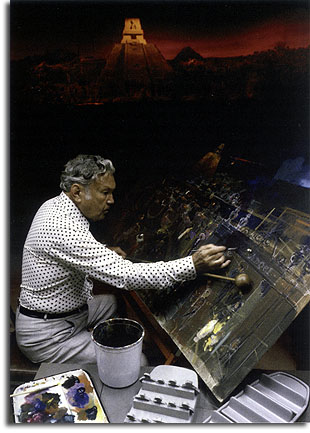
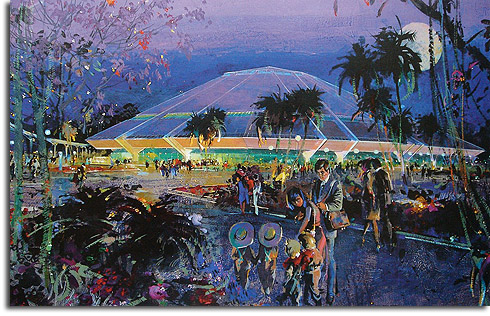
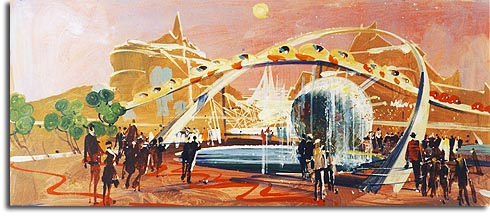


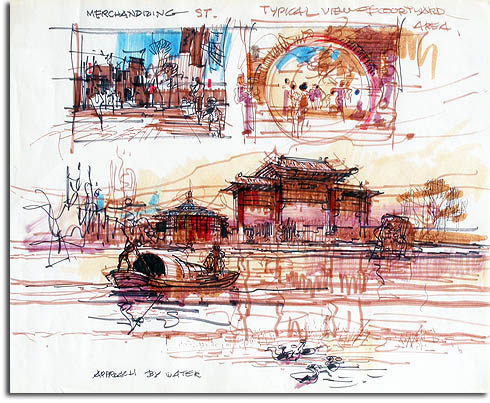
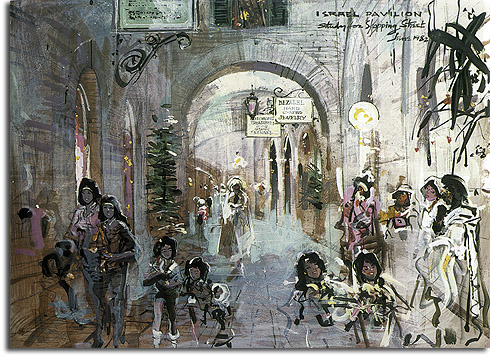
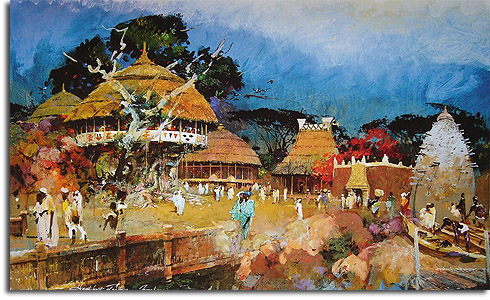
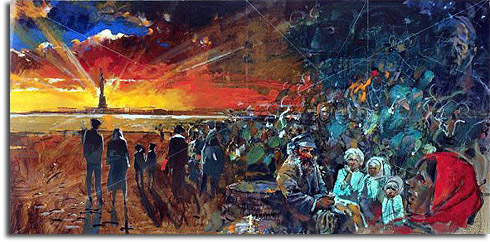
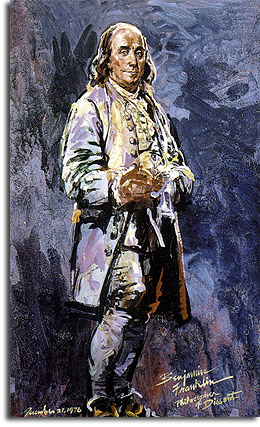









The rendering of the exterior of The American Adventure is particularly striking… The America Gardens Theatre is a great venue, but it would be BEAUTIFUL to have an unobstructed view of the Colonial facade from across the lagoon.
If only indeed! Some of those paintings are so inviting I wish I could just walk into them, in the style of “Voyage of the Dawn Treader.”
Who could turn any of that down!
Wasn’t there some very, very very early concept for ECPOT Center that involved “living paintings”. Maybe an idea for the French showcase and somewhat akin to the ‘Pagent of the Masters’ in Laguna Beach?
These renderings are partially the reason why, as a kid, it was hard not to be disappointed with any new Disney construction because how in the world could it possibly live up to images like these? I mean, each of these images of the Showcase pavilions is like a window into the nation itself – it implies a whole, enormous world beyond the edges of the rendering. None of these could be simple attractions….
I felt the same way about Tim Delaney’s renderings of The Living Seas. That wasn’t going to be an attraction, it was going to be a world.
Mark – your point about American Gardens Theatre is a good one. The pavilion, with some landscaping in front, would be striking across the lagoon. It’s a good venue, but it is an eyesore.
AV – I hadn’t heard that, although it definitely sounds plausible! I’ll keep an eye out for that.
Very usefull post can i translate into Spanish for our blogs viewers? Thanks
Michael:
I’ve been going through some of your archives and I would just like to say that this is a phenomenal piece. I am astounded by your “library” of large, high-quality Disney renderings. After seeing these, I have decided to pursue my passion and get my Masters in Architecture (some 5 years after graduating college). Thanks for the inspiration in this well-written piece.
Funny that the architecture depicted by Herby for the Israel pavilion is typically the Arab arches of East Jerusalem, built by the Memluks of the 13th century… Thanks, Mr.Ryman for documenting the realities of Israel…